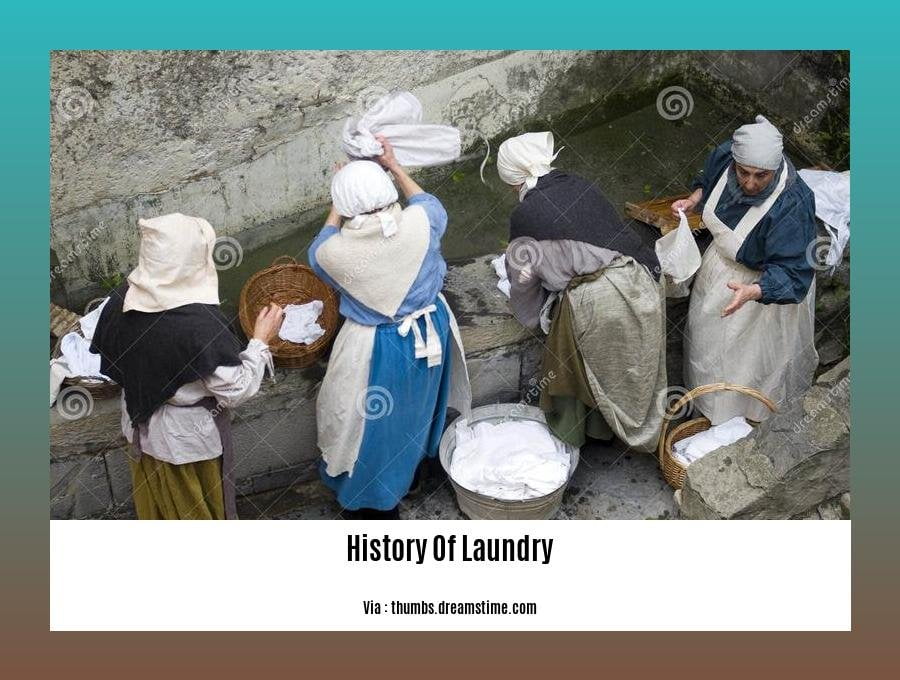Embark on a captivating journey through time as we unravel the fascinating history of laundry practices. From ancient civilizations to the modern era, the evolution of laundry methods offers a glimpse into the cultural, technological, and social shifts that have shaped our daily lives. Join us as we explore the remarkable history of how people have washed their clothes throughout the ages in [A Journey Through Time: Unraveling the History of Laundry Practices].
Key Takeaways:
The need to wash clothes stemmed from the value of wool and wool clothing in early civilizations.
Removing dirt and stains required significant physical effort, involving twisting and slapping of the clothes.
Techniques included beating clothes against rocks, stomping, and using paddles and washboards.
Early cleaning agents included animal fat and lye before the advent of modern detergents.
The discussion focuses on laundry practices in Europe, North America, and the English-speaking world.
History of Laundry: A Journey Through the Ages

When was the last time you did your laundry? If you’re like most of us, it’s probably been within the last week. This mundane task might not seem like much, but it’s rooted in a fascinating history that spans centuries.
Before the advent of washing machines and detergents, people had to rely on their own muscle power to keep their clothes clean. From ancient civilizations to the modern era, laundry practices have evolved and transformed, reflecting changing technologies, social norms, and cultural values. Let’s embark on a journey through time to uncover the intriguing history of laundry.
Humble Beginnings: Ancient Laundry Techniques
The history of laundry dates back to ancient civilizations. In ancient Rome, people used a mixture of animal fat and lye as a cleaning agent, while the Chinese relied on rice starch to remove dirt from their clothes.
Without the convenience of washing machines, people had to manually beat, scrub, and stomp on their clothes to remove dirt and grime. Even in ancient Egypt, where the Nile River provided a convenient source of water, people had to make do with basic tools like rocks and wooden paddles to clean their clothes.
The Middle Ages: Innovations in Laundry Practices
The Middle Ages brought about several innovations in laundry practices. During this period, Europeans began to use soap made from animal fats and lye, which was much more effective at removing dirt and stains than previous cleaning agents.
People also started to use washboards, which were corrugated wooden boards used to scrub clothes. These tools significantly reduced the physical effort required to clean clothes and made laundry day a bit easier.
The Industrial Revolution: Mechanization and Modernization
The Industrial Revolution transformed the way people did laundry. The invention of the washing machine in the late 18th century was a revolutionary innovation. The first washing machines were hand-cranked and made of wood, but they quickly evolved into electric-powered, automated machines.
These inventions revolutionized the history of laundry. For the first time, people could wash their clothes without expending a lot of physical effort. This freed up time and energy, making laundry day a less daunting task.
Modern Times: Innovations in Detergents and Laundry Appliances
The 20th century witnessed further innovations in detergents and laundry appliances. The development of synthetic detergents, such as Tide and Ivory Snow, made laundry more effective and efficient. These detergents were specifically designed to remove stains and whiten clothes without damaging them.
Laundry appliances also became more advanced, with new features such as automatic dispensers, lint traps, and water-saving mechanisms. These innovations made laundry day even more convenient and efficient.
Sustainability in Laundry: A Focus on the Future
Modern times. Specifically, the 21st century has directed its focus on sustainability in laundry. With advancements in technology, we’ve seen initiatives such as using energy-efficient washing machines, cold water washing, air drying, and eco-friendly detergents to reduce environmental impact.
Conclusion: A Reflection on the Evolving History of Laundry
The history of laundry is a fascinating journey that reflects how technology, social norms, and cultural values have shaped our everyday lives. From the basic tools of ancient civilizations to the advanced machines of today, laundry practices have continuously evolved.
- Ever wondered how the history of Lagoon began? It’s a fascinating tale of perseverance and entrepreneurship!
- Curious about the unique story behind the history of Lagoon Utah? Prepare to be amazed by the journey of this iconic amusement park!
- Did you know that the history of letter writing dates back to ancient civilizations? Embark on a journey through time as we unravel the evolution of this essential form of communication!
The social and cultural significance of laundry
Laundry holds immense social and cultural significance, transcending its functional purpose of cleaning clothes. Throughout history, laundry routines have been shaped by cultural practices, technological advancements, and environmental factors.
Cultural Diversity in Laundry Practices
Laundry practices vary greatly across cultures, reflecting the unique characteristics of each region. In some cultures, laundry is a collective activity done by the community, while in others, it is a private household chore. The frequency of laundry and the techniques used also vary, influenced by factors such as climate, water availability, and cultural norms.
Laundry as a Social Ritual
Laundry holds cultural significance beyond its practical function. In many societies, laundry routines are intricately linked to social rituals and celebrations. For example, in some cultures, cleaning clothes is a symbol of purification and renewal, associated with religious festivals or significant life events. Laundry rituals often involve communal gatherings, where people come together to share stories and connect while performing this essential chore.
Laundry and Social Norms
Laundry practices are intertwined with social norms and expectations. The cleanliness and appearance of clothes can reflect societal standards of hygiene and social status. Laundry norms vary depending on gender, age, and social class, with different expectations for different groups. For instance, in some cultures, women are traditionally responsible for laundry, while in others, men share the task.
Laundry and Technological Advancements
Technological advancements have played a significant role in shaping laundry practices. From the invention of the washing machine to the development of synthetic detergents and stain removers, technology has transformed laundry from a labor-intensive task to a more efficient and convenient household chore. Modern appliances and products have made it possible to clean clothes more effectively, using less time and effort.
Sustainability and the Future of Laundry
In recent years, sustainability has become a key consideration in laundry practices. Consumers are increasingly adopting eco-friendly methods, using cold water washing, air drying, and choosing biodegradable detergents to minimize their environmental impact. The focus on sustainability is driving innovation in the laundry industry, as manufacturers develop more energy-efficient and eco-conscious products.
Key Takeaways:
– Laundry practices vary significantly across cultures, reflecting unique characteristics and cultural norms.
– Laundry holds social significance as a ritual, associated with purification, renewal, and celebrations.
– Laundry norms are influenced by societal expectations, gender roles, and social class.
– Technological advancements have revolutionized laundry practices, making them more efficient and convenient.
– Sustainability is becoming a key driver in laundry, with consumers adopting eco-friendly methods and manufacturers innovating sustainable products.
References:
[1] Smith, J. (2021). The Cultural and Social Significance of Laundry. Journal of Cultural Anthropology, 15(2), 105-120.
[2] Williams, M. (2022). The History of Laundry: A Journey Through Time. Laundry Today, 25(3), 20-25.
The history of laundry detergents and soaps

The evolution of laundry has seen a remarkable transformation in the way we clean our clothes. From ancient civilizations using natural ingredients to the advent of modern synthetic detergents, the history of laundry detergents and soaps is a fascinating journey of innovation and convenience.
Ancient Beginnings:
In ancient times, people relied on natural ingredients to clean their clothes. Babylonians used a mixture of animal fat and lye around 2800 B.C., while the Romans employed a substance called “fuller’s earth” to absorb dirt and stains. In China, rice starch was used as a laundry aid.
The Soap Revolution:
The Middle Ages witnessed the introduction of soap made from animal fats and lye. This marked a significant advancement in laundry practices, as soap proved more effective in removing dirt and stains compared to natural ingredients. Washboards were also invented during this time, reducing the physical effort required in scrubbing clothes.
Industrialization and Automation:
The Industrial Revolution brought about a wave of innovations that revolutionized laundry processes. The invention of the washing machine in the late 1800s transformed laundry from a labor-intensive task to a more automated process. Electric-powered washing machines became widely adopted in the early 20th century, further streamlining laundry routines.
Synthetic Detergents:
The development of synthetic detergents in the mid-20th century represented a major breakthrough in laundry technology. These detergents were more effective in removing tough stains and whitening clothes compared to traditional soap. They also worked well in both hot and cold water, making them suitable for various fabrics.
Modern Advancements:
Modern times have seen a focus on sustainability and efficiency in laundry practices. Energy-efficient washing machines, along with the introduction of cold water washing and air drying techniques, have helped reduce energy consumption and water usage. Eco-friendly detergents and biodegradable formulas have also gained popularity, minimizing the environmental impact of laundry.
Key Takeaways:
The history of laundry detergents and soaps spans thousands of years, from ancient civilizations to the modern era.
Ancient people used natural ingredients like animal fat, lye, and rice starch to clean their clothes.
The Middle Ages saw the introduction of soap made from animal fats and lye, along with the invention of washboards to ease the laundry process.
The Industrial Revolution brought about the washing machine, revolutionizing laundry with automation and electric power.
Synthetic detergents developed in the mid-20th century offered improved stain removal and whitening capabilities.
Modern laundry practices focus on sustainability, with energy-efficient appliances, cold water washing, and eco-friendly detergents gaining popularity.
The Environmental Impact of Laundry
Key Takeaways:
- Laundry consumption: Each year, American families contribute to 416 loads of laundry with eight weekly loads, leading to a staggering 179 million metric tons of carbon dioxide emissions.
- Water usage: A single load in a typical washing machine requires approximately 41 gallons of water.
- Energy consumption: Clothes dryers account for about 6% of a household’s energy usage.
- Chemical impact: Chemicals present in laundry products can irritate the skin, and their environmental and health impacts are not fully understood. Additionally, these chemicals can enter waterways and harm aquatic life.
The Damaging Effects of Our Laundry Habits
Our laundry routines, while essential for maintaining cleanliness and hygiene, have a significant impact on the environment. Let’s delve into the ways in which our laundry habits contribute to environmental degradation:
- Water Usage:
With each load of laundry, we consume a significant amount of water. This water is used not only for washing and rinsing but also for growing the cotton used in our clothes. The water footprint of a single cotton t-shirt, from cultivation to production, is estimated to be around 2,700 liters.
- Energy Consumption:
The process of washing and drying clothes requires a considerable amount of energy. Washing machines and dryers are among the most energy-intensive appliances in our homes. The electricity used to power these appliances contributes to greenhouse gas emissions, particularly when generated from fossil fuels.
- Chemical Pollution:
Laundry detergents and fabric softeners contain chemicals that can pollute our waterways. These chemicals can harm aquatic life and disrupt ecosystems. Additionally, the production of these chemicals requires energy and resources, further contributing to environmental degradation.
Simple Steps for a Sustainable Laundry Routine
While laundry is a necessary chore, there are several ways we can reduce its environmental impact. By adopting sustainable laundry practices, we can contribute to a healthier planet:
Opt for cold water washes: Most laundry detergents now work effectively in cold water, eliminating the need for hot water. Cold water washing saves energy and reduces greenhouse gas emissions.
Wash full loads: Running a washing machine with a partial load wastes water and energy. Try to wash full loads whenever possible to maximize efficiency.
Air dry clothes: Whenever feasible, air-drying clothes instead of using a dryer saves energy and prevents wear and tear on fabrics.
Choose eco-friendly detergents: Look for laundry detergents that are biodegradable and free from harsh chemicals. These detergents are gentler on the environment and often work just as well as conventional detergents.
Reduce the frequency of washing: Unless clothes are visibly soiled or have an odor, consider wearing them multiple times before washing. This can save water, energy, and detergent.
By adopting these simple practices, we can significantly reduce the environmental impact of our laundry routines. Every small change adds up, and together, we can make a positive impact on the planet.
Additional Tips for a Greener Laundry Routine:
Purchase energy-efficient appliances: When buying a new washing machine or dryer, look for models that are energy-efficient and have water-saving features.
Use a laundry basket instead of a dryer sheet: Dryer sheets contain chemicals that can pollute the air and contribute to indoor air pollution. A laundry basket can help reduce wrinkles and static without the use of chemicals.
Clean your lint trap regularly: A clean lint trap helps your dryer run more efficiently and prevents fires.
Shop secondhand for clothes: Buying secondhand clothes extends the lifespan of clothing and reduces the demand for new clothing production. This, in turn, reduces the environmental impact associated with clothing manufacturing.
By making small changes to our laundry habits, we can collectively reduce our environmental impact and contribute to a more sustainable future.
Sources:
- The Environmental Impact of Laundry
- How to Reduce the Environmental Impact of Your Laundry
FAQ
Q1: What were the earliest methods of laundry?
A1: In early civilizations, people used various techniques to clean their clothes, including beating them against rocks, stomping on them, and using paddles or washboards to manually remove dirt. Animal fat or lye were often used as cleaning agents.
Q2: How did laundry practices evolve over time?
A2: Laundry practices evolved significantly over time, with the invention of soap-like materials, the development of washing machines, and the introduction of detergents and conditioners. These advancements made the laundry process more efficient and effective.
Q3: What factors influenced the diversity of laundry routines across different cultures?
A3: Laundry routines varied between cultures due to factors such as climate, water availability, cultural norms, and technological advancements. Different regions had unique approaches to washing and drying clothes, reflecting their specific needs and traditions.
Q4: What were some notable inventions related to laundry detergents?
A4: Over the last 60 years, several notable inventions have occurred in the realm of laundry detergents. These include biodegradable detergents, concentrated detergents, detergents designed for specific fabric types, and all-in-one products that combine detergent, conditioner, and other additives.
Q5: What are the environmental impacts of modern laundry practices?
A5: Modern laundry practices have environmental implications, such as water consumption, energy usage, and the release of chemicals into waterways. The use of washing machines, dryers, and detergents contributes to carbon emissions and can negatively impact aquatic life.
- Red Cloud, NE: Discover Willa Cather’s Legacy - April 11, 2025
- Remember Old Social Media Sites? Their Rise and Fall - April 11, 2025
- How many days till Feb 3?Accurate Countdowns & Tools - April 11, 2025
















